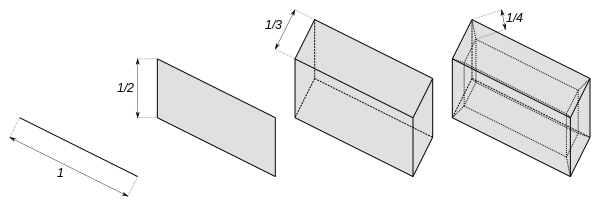In mathematics, the Hilbert cube, named after David Hilbert, is a topological space that provides an instructive example of some ideas in topology. Furthermore, many interesting topological spaces can be embedded in the Hilbert cube; that is, can be viewed as subspaces of the Hilbert cube (see below).

Definition
The Hilbert cube is best defined as the topological product of the intervals for That is, it is a cuboid of countably infinite dimension, where the lengths of the edges in each orthogonal direction form the sequence
The Hilbert cube is homeomorphic to the product of countably infinitely many copies of the unit interval In other words, it is topologically indistinguishable from the unit cube of countably infinite dimension. Some authors use the term "Hilbert cube" to mean this Cartesian product instead of the product of the .
If a point in the Hilbert cube is specified by a sequence with then a homeomorphism to the infinite dimensional unit cube is given by
The Hilbert cube as a metric space
It is sometimes convenient to think of the Hilbert cube as a metric space, indeed as a specific subset of a separable Hilbert space (that is, a Hilbert space with a countably infinite Hilbert basis). For these purposes, it is best not to think of it as a product of copies of but instead as as stated above, for topological properties, this makes no difference. That is, an element of the Hilbert cube is an infinite sequence that satisfies
Any such sequence belongs to the Hilbert space so the Hilbert cube inherits a metric from there. One can show that the topology induced by the metric is the same as the product topology in the above definition.
Properties
As a product of compact Hausdorff spaces, the Hilbert cube is itself a compact Hausdorff space as a result of the Tychonoff theorem. The compactness of the Hilbert cube can also be proved without the axiom of choice by constructing a continuous function from the usual Cantor set onto the Hilbert cube.
In no point has a compact neighbourhood (thus, is not locally compact). One might expect that all of the compact subsets of are finite-dimensional. The Hilbert cube shows that this is not the case. But the Hilbert cube fails to be a neighbourhood of any point because its side becomes smaller and smaller in each dimension, so that an open ball around of any fixed radius must go outside the cube in some dimension.
Any infinite-dimensional convex compact subset of is homeomorphic to the Hilbert cube. The Hilbert cube is a convex set, whose span is the whole space, but whose interior is empty. This situation is impossible in finite dimensions. The tangent cone to the cube at the zero vector is the whole space.
Every subset of the Hilbert cube inherits from the Hilbert cube the properties of being both metrizable (and therefore T4) and second countable. It is more interesting that the converse also holds: Every second countable T4 space is homeomorphic to a subset of the Hilbert cube.
Every Gδ-subset of the Hilbert cube is a Polish space, a topological space homeomorphic to a separable and complete metric space. Conversely, every Polish space is homeomorphic to a Gδ-subset of the Hilbert cube.
See also
- List of topologies – List of concrete topologies and topological spaces
Notes
- Friedman 1981, p. 221.
- Srivastava 1998, p. 55.
References
- Friedman, Harvey (1981). "On the necessary use of abstract set theory" (PDF). Advances in Mathematics. 41 (3): 209–280. doi:10.1016/0001-8708(81)90021-9. Retrieved 19 December 2022.
- Srivastava, Shashi Mohan (1998). A Course on Borel Sets. Graduate Texts in Mathematics. Springer-Verlag. ISBN 978-0-387-98412-4. Retrieved 2008-12-04.
- "Die Homoiomorphie der kompakten konvexen Mengen im Hilbertschen Raum" [The homomorphism of the compact convex sets in Hilbert space] (in German). EUDML. Archived from the original on 2020-03-02.
Further reading
- Steen, Lynn Arthur; Seebach, J. Arthur Jr. (1995) . Counterexamples in Topology (Dover reprint of 1978 ed.). Berlin, New York: Springer-Verlag. ISBN 978-0-486-68735-3. MR 0507446.
 for
for  That is, it is a
That is, it is a 
 In other words, it is topologically indistinguishable from the
In other words, it is topologically indistinguishable from the  .
.
 with
with  then a homeomorphism to the infinite dimensional unit cube is given by
then a homeomorphism to the infinite dimensional unit cube is given by 
 but instead as
but instead as
 as stated above, for topological properties, this makes no difference.
That is, an element of the Hilbert cube is an
as stated above, for topological properties, this makes no difference.
That is, an element of the Hilbert cube is an  that satisfies
that satisfies


 is not
is not  because its side becomes smaller and smaller in each dimension, so that an
because its side becomes smaller and smaller in each dimension, so that an  must go outside the cube in some dimension.
must go outside the cube in some dimension.